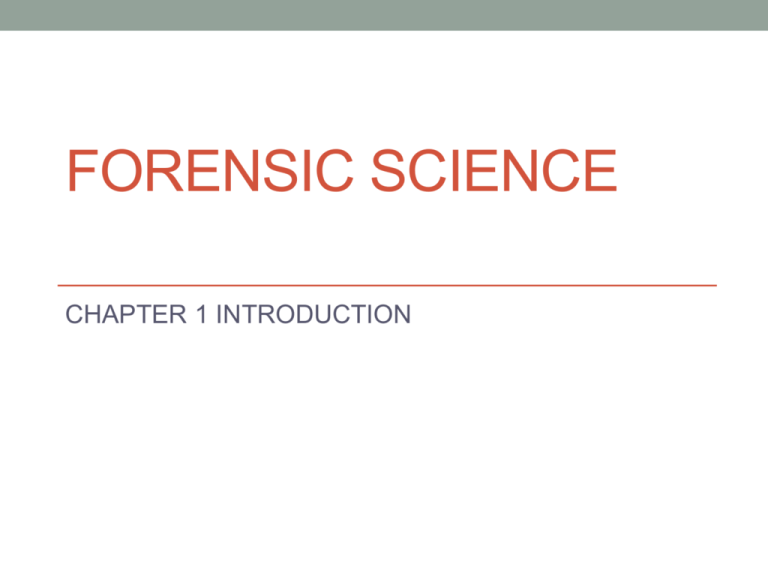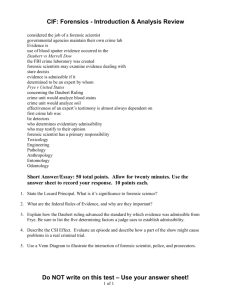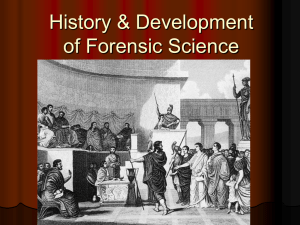Forensic Science
advertisement

FORENSIC SCIENCE CHAPTER 1 INTRODUCTION Learning Objectives • Describe how the scientific method is used to solve forensic problems. • Provide examples of the growth and development of forensic science through history. • Understand the relationship between our legal system and prosecution of criminals. What is forensic science? • The study and the application of science to matters of law. Criminology Includes the psychological angle: studying the crime scene for motive, traits, and behavior that will help to interpret the evidence So what does a crime lab look like? • Physical science unit Chemistry Physics Geology • Biology unit • Firearms and ballistics unit • Document examination unit • Photography unit The most common types of evidence examined are drugs, firearms, and fingerprints. https://www.youtube.com/watch?v=bztlYwckmVE What specialties are found in a crime lab? • Forensic pathology • Cybertechnology • Forensic anthropology • Geology • Forensic entomology • Environmental science • Forensic psychiatry • Palynology • Forensic odontology • Polygraphy • Forensic engineering • Voiceprint analysis Federal Crime Labs • FBI: Federal Bureau of Investigation • DEA: Drug Enforcement Agency • ATF: Alcohol, Tobacco, and Firearms • USPS: United States Postal Service • U.S. Fish and Wildlife Service • Department of Homeland Security • Department of the Treasury Scientific Method in forensic science • Observe a problem or questioned evidence and collect • • • • objective data. Consider a hypothesis or possible solution. Examine, test, and then analyze the evidence. Determine the significance of the evidence. Formulate a theory based on evaluation of the significance of the evidence. The Locard’s Principle • Locard's principle holds that the perpetrator of a crime will bring something into the crime scene and leave with something from it, and that both can be used as forensic evidence. Criminal justice and the law • Statutory law passed by bodies such as Congress. Based on the Constitution. • Common law based on judicial opinions or precedents • Civil law based on non criminal suits to preserve individual or civil rights • Criminal law concerned with offenses against an individual that are not acceptable to society • Misdemeanor = minor crime – minor possession of drugs • Felony = major crime such as murder The Bill of Rights Guarantees; 1. Presumed innocent until proven guilty 2. Not to be searched unreasonably 3. Not to be arrested without probable cause 4. Against unreasonable seizure of personal property 5. Against self-incrimination 6. To fair questioning by police 7. To protection from physical harm throughout the justice process 8. To an attorney 9. To trial by jury 10. To know any charges against oneself Steps in pursuing justice • Miranda rights – police must inform arrestees that they have the right to remain silent and a right to an attorney. • Steps involved in court cases 1. Arraignment – defendant hears charges and enters plea 2. Evidentiary hearing – evidence presented and charges filed or dismissed. 3. Grand jury decides whether to indict 4. Plea bargain – a defendant pleads guilty in return for a lesser charge Admissibility of Evidence • Evidence must be probative (must prove something. Hearsay is inadmissible. • The Daubert Ruling – used mostly in federal courts • The judge decides if the evidence can be entered into the trial. Admissibility is determined by: 1. Whether the theory or technique can be tested 2. Whether the science has been offered for peer review 3. Whether the rate of error is acceptable 4. Whether the method at issue enjoys widespread acceptance 5. Whether the theory or technique follows standards Key Vocabulary terms • Criminalistics • Evidence • Forensics • Pathology • Entomology • Odontology • Toxicology • Locard Principle • Criminal law • Civil Law • Misdemeanor • Felony Probable cause Miranda rights Arraignment Grand jury Indict Probative Arson Hearsay Expert witness Frye Standard Daubert ruling/Junk science






